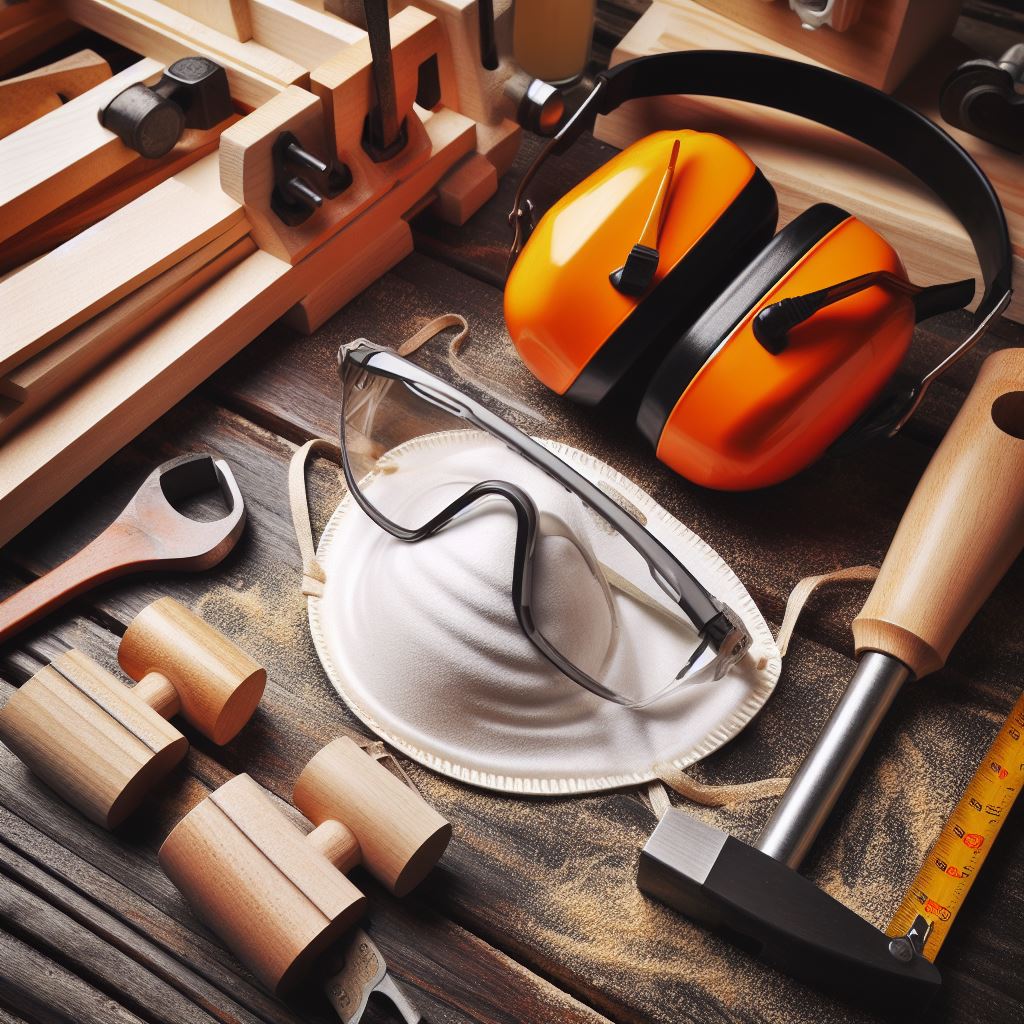
- Introduction
- 1. Use Machine Guards
- 2. Wear Proper Safety Gear
- 3. Maintain Good Housekeeping
- 4. Control Dust
- 5. Have Fire Safety Equipment
- 6. Learn First Aid Basics
- 7. Clearly Mark Exits
- 8. Follow Chemical Safety Rules
- 9. Seek Continuing Education
- 10. Foster a Culture of Safety
- Conclusion
- Frequently Asked Questions
Working with wood comes with inherent risks. From sharp tools and heavy machinery to dust and chemicals, a woodshop contains a multitude of hazards. Implementing proper safety protocols is crucial for protecting yourself and those around you.
This article outlines the top 10 safe workshop practices for woodworkers. Adhering to these simple safety tips will help you avoid accidents and work confidently in your shop.
Introduction
Maintaining a safe working environment should be the number one priority for any woodworker. However, it’s easy to become complacent over time and neglect safety measures. Developing good safety habits from day one and making safety protocols part of your regular workflow is key.
Don’t wait until an accident happens to make changes. Be proactive and take preventative measures to ensure you have a safe woodshop. Use the safety checklist below to audit your workspace and identify areas for improvement.
| Safety Audit Checklist | |
|---|---|
| Proper machine guarding in place | ☐ |
| Good housekeeping – clean shop & organized tools/materials | ☐ |
| Fire safety equipment installed & maintained | ☐ |
| First aid kit stocked and accessible | ☐ |
| Clearly marked emergency exits | ☐ |
| Safety gear worn when operating machinery | ☐ |
| Dust collection system functioning | ☐ |
| Safety signage posted on machines & in shop | ☐ |
Following proper safety protocols is non-negotiable. Don’t let an accident cut your woodworking passion short. Review these top woodshop safety tips regularly and make safety your top workshop priority.
1. Use Machine Guards
One of the most important woodshop safety tips is utilizing machine guards. Table saws, band saws, jointers, lathes and other stationary power tools have a variety of moving parts that can easily cause devastating injuries if contacted.
Installing machine guards greatly reduces the risk of accidental contact with blades, belts, pulleys and other hazardous moving components. Never remove a guard to “get a better view”. If visibility is an issue, make adjustments so you can properly see while keeping guards in place.
2. Wear Proper Safety Gear

Another fundamental woodworking machine safety measure is wearing appropriate safety gear while operating machinery. This includes:
- Safety glasses – Protect eyes from flying chips and sawdust
- Hearing protection – Shield ears from loud machine noise
- Respirator mask – Filter out harmful dust particles
- Gloves – Guard hands from sharp edges
Also avoid loose clothing, jewelry or unrestrained long hair that could get caught in moving parts. Wear snug fitting clothes and tie back long hair.
Make putting on safety gear an automatic habit before starting any machine. Consistently modeling safe behaviors ensures others in your shop do the same.
3. Maintain Good Housekeeping
While not directly related to machine dangers, maintaining orderly shop conditions prevents a host of potential accidents. Good housekeeping safety practices include:
- Keep floors free of slip/trip hazards
- Return tools to marked storage locations after use
- Clean up sawdust frequently
- Organize lumber stacks neatly
- Avoid cluttered workbenches
- Secure cords out of walkways
Designating specific areas to keep tools, lumber, scrap, finishes and other materials encourages orderly habits. Bonus – you’ll work more efficiently in a clean shop!
4. Control Dust
Airborne wood dust is a common workshop hazard that can cause serious respiratory issues. Some woods contain natural irritants that can provoke allergic reactions. Prolonged fine dust inhalation often leads to chronic lung disease.
Controlling dust at the source is critical. Use dust collection systems on woodworking machinery to capture most airborne particles before they spread. Also wear an N95 respirator mask when working in dusty conditions.
Thoroughly cleaning your shop with a fine dust filter vacuum further reduces lingering particulate matter. Proper dust control keeps you breathing easy.
5. Have Fire Safety Equipment
Wood dust buildup coupled with combustible materials makes workshops prone to fire hazards. It’s imperative to have fire safety equipment installed and maintained. This includes:
- Fire extinguishers – Class ABC extinguishers that suppress wood/electrical/liquid fires
- Smoke detectors – Hardwired and battery operated units
- Sprinklers – Wet pipe or dry pipe systems
- Fire alarms – Audible and visual alarm devices
Check fire equipment functionality regularly. Replace expired fire extinguishers. Change smoke detector batteries twice a year. Keep exits and equipment free of obstructions. Know how sprinklers operate. Understanding proper fire safety protocol prevents minor incidents from becoming major catastrophes.
6. Learn First Aid Basics
Even with strict safety measures, woodshop accidents sometimes happen. Having first aid knowledge and supplies readily available helps minimize injury severity. Keep well-stocked first aid kits stationed around your workshop and make sure they are clearly visible and accessible. At a minimum, kits should contain:
- Sterile gauze & bandages
- Antibiotic & antiseptic ointments
- Eyewash solution
- Medical tape
- Nitrile gloves
- Trauma shears
- Cold packs
Go beyond just having first aid supplies and get training in emergency response care. Take a first aid course specializing in treating puncture wounds, blunt force trauma, burns and amputations. Knowing how to quickly provide appropriate care makes all the difference.
7. Clearly Mark Exits
In case of fire or other emergency, clearly marked exits enable quick evacuation from the workshop. Define and label at least two routes out of your shop space using reflective signs placed at eye level.
Keep exits and pathways leading to them free of debris and obstacles at all times. Ensure exit doorways function smoothly and are wide enough for easy passage.
Install emergency lighting near exits that automatically activates if the power fails. The ability to swiftly locate exits prevents panic and supports safe evacuation.
8. Follow Chemical Safety Rules
Various flammable, toxic and corrosive substances get used in wood finishing and maintenance. Using chemicals improperly seriously jeopardizes health and safety. Strictly follow usage guidelines and storage protocols for stains, paints, solvents, degreasers, oils, glues and other dangerous materials.
Key chemical safety rules include:
- Read product warning labels carefully
- Wear skin/eye protection when handling
- Mix outdoors or in well-ventilated areas
- Measure accurately – no guessing!
- Follow manufacturer storage instructions
- Never mix chemicals unless specifically advised
- Properly label containers
- Dispose of hazardous waste correctly
Respecting chemicals prevents harmful exposures that damage health. Understand risks before introducing any new product into your woodshop.
9. Seek Continuing Education
Advancing your woodworking knowledge directly correlates with increased safety. Seeking continuing woodworking education through classes, training programs, demonstrations and certifications exposes you to best practices and latest technologies that engineered to enhance safety.
Investing time specifically into learning safety techniques ensures you don’t develop bad habits that compromise welfare. For example, take a professional workshop covering table saw use to learn precise methods for making safe rip cuts.
10. Foster a Culture of Safety
If you operate a professional or hobbyist woodshop with others, the responsibility for safety extends beyond just yourself. Promoting an ongoing culture of safety ensures everyone works securely. This means:
- Establishing clear safety policies
- Training everyone on protocol
- Leading by example – model safe behaviors
- Encouraging questions & input from team
- Emphasizing safety over productivity
- Enforcing rules firmly and consistently
- Routinely auditing procedures
Cultivating shared safety values, rather than just dictating rules, gets everyone invested in sustaining safe shop conditions long term. Make safety a frequent, open conversation.
Conclusion
The top 10 woodshop safety tips outlined above provide a blueprint for a creating a secure workshop environment. However, improving safety requires more than just one-time actions – it necessitates establishing safe practices into regular habits.
Consistently following safety protocols protects your health and ability to continue woodworking. Review this list often as you work to identify areas needing more attention. Don’t become complacent. Spend time each month retraining staff, running practice emergency drills, fine tuning precautions, and updating procedures.
If an accident still strikes, thoroughly analyze what happened and adjust your safety program accordingly. Use any incidents as learning experiences. By continuously monitoring and enhancing your woodshop safety protocols, you’ll ensure many future years enjoying your woodworking passion.
Frequently Asked Questions
What are the most common woodshop accidents?
The most frequent woodworking injuries result from contact with blades on stationary power tools. Table saw accidents tend to be the most severe – accounting for over 36,000 ER visits annually. Band saws, jointers, planers and router tables also cause many injuries.
What safety features should I install on my table saw?
Essential table saw safety features include blade guards, riving knives, anti-kickback pawls, featherboards, push sticks and emergency power switches. Upgrade to modern saws with flesh detection and blade braking technologies.
Is a dust mask good enough when working in my shop?
No! A simple dust mask does not provide adequate protection from wood dust. Wear an N95 respirator mask fitted precisely to your face to filter fine particles. Always use dust collection systems too.
What fire extinguisher type is best for a wood shop?
Class ABC dry chemical extinguishers designed to suppress wood, paper, liquid and electrical fires provide the versatility needed for woodshop fires. Maintain a minimum rating of 4A:80B:C and locate extinguishers around the shop within 75 feet of any point.
Should I create an evacuation plan for my small garage woodshop?
Absolutely! No shop is too small for an emergency plan. Map out primary and secondary exit routes in all conditions and practice evacuation drills. Post exit signs so emergency personnel can also locate exits if needed.
What personal protective equipment should be mandatory in a shop?
At minimum, wearing safety glasses, hearing protection, dust masks, and closed toe shoes should be compulsory when operating machinery. Require appropriate gloves, aprons, arm guards and other gear as needed for specific tools. Enforce PPE standards firmly.
Where can I find more resources about woodshop safety best practices?
For comprehensive woodworking safety advice, visit guilds like the American Woodworking Association (www.awanet.org) or trade groups like the Power Tool Institute (www.powertoolinstitute.com).
By consistently referring to this article, using the takeaway checklist, and reviewing the answers above, you’ll be well on your way to developing optimal safe working habits that enable you to confidently pursue woodworking projects while avoiding preventable accidents.

